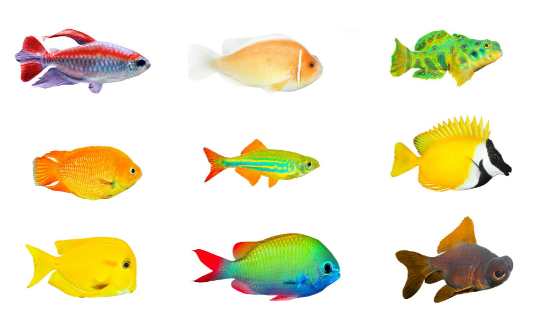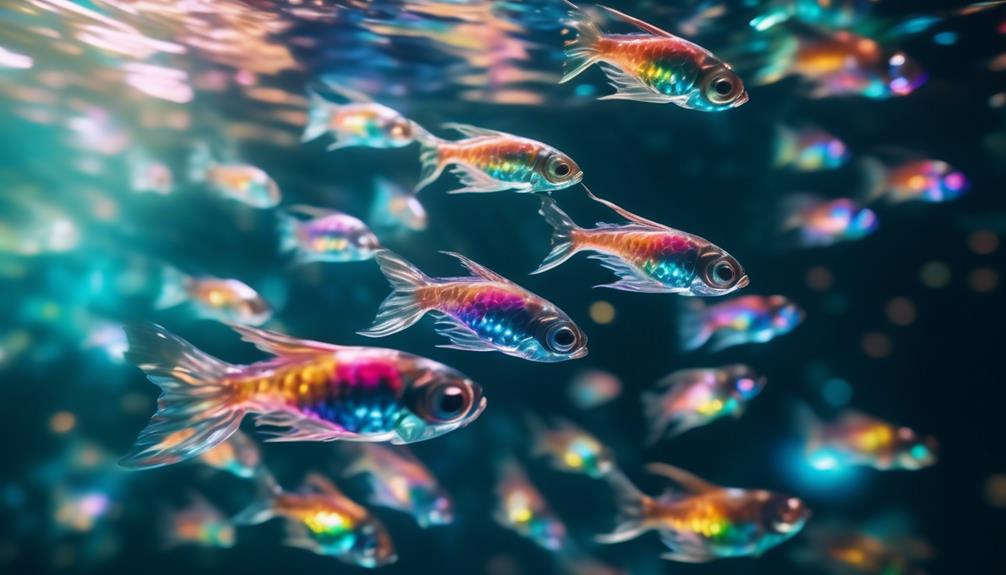
Step into the realm of the aquatic unknown, where reality and enchantment collide. Prepare to be mesmerized by the mystical glass fish, those captivating creatures that seem to defy the very laws of nature.
As you embark on this journey, you will uncover the secrets behind their transparent bodies, granting you a glimpse into their mesmerizing inner world.
But that’s not all – there is so much more to discover about these transparent marvels of the aquatic world.
So, brace yourself for a captivating exploration that will leave you in awe of the enigmatic glass fish.
Key Takeaways
- Glass fish, also known as Indian Glassy Fish, are completely transparent, revealing their bones and internal organs.
- They are shy and peaceful, and it is best to keep them in groups of 5 or more.
- Glass fish are native to South Asia and can be found in standing freshwater, such as impoundments. The myth that they need to live in brackish water is false.
- Glass fish are small in size, reaching about 3 inches in length, and they require a spacious tank with heavy vegetation and rocks. They are carnivores and can be fed live, frozen, or freeze-dried foods.
Glass Fish: The Wonders of Transparency
Prepare to be amazed by the mystical glass fish and its incredible transparency.
The glass fish, also known as the Indian Glassy Fish, Indian Glassy Perch, Indian X-Ray Fish, Siamese Glassfish, or Malaysian Glassy Fish, has a completely transparent body that reveals its bones and internal organs. This unique feature makes it a captivating sight in any aquarium.
Glass fish have a shy and peaceful temperament, which makes them best kept in groups of 5 or more. It’s important to avoid buying dyed glassfish or disco fish, as these are unnatural and can harm the fish.
Native to South Asia, from Pakistan to Malaysia, glass fish occur in standing freshwater, such as impoundments. Contrary to popular belief, they don’t need to live in brackish water.
In terms of color, glass fish are completely transparent. However, males may develop a black tinge on their dorsal fins. Any traces of exotic, vivid colors are the result of artificial dyeing.
When it comes to maintenance and care, glass fish are small species that grow up to about 3 inches in length. They need a spacious tank, preferably a minimum of 10 to 20 gallons, with heavy vegetation and rocks. The water should be slightly acidic to slightly alkaline, with a pH value of 6.5 to 7.5.
Glass fish are peaceful species and make excellent tank mates for other small to medium-sized, non-aggressive fishes.
In terms of feeding, glass fish are carnivores and thrive on live foods such as mosquito larvae, tubiflex worms, and blood worms. They can also be fed frozen and freeze-dried foods.
Breeding can be induced in the aquarium by adding small amounts of freshwater and increasing water temperature. However, it’s important to note that adults may eat their own eggs and fry, so a breeding pair should be separated into a heavily planted spawning tank.
Origins of Glass Fish: South Asian Beauties
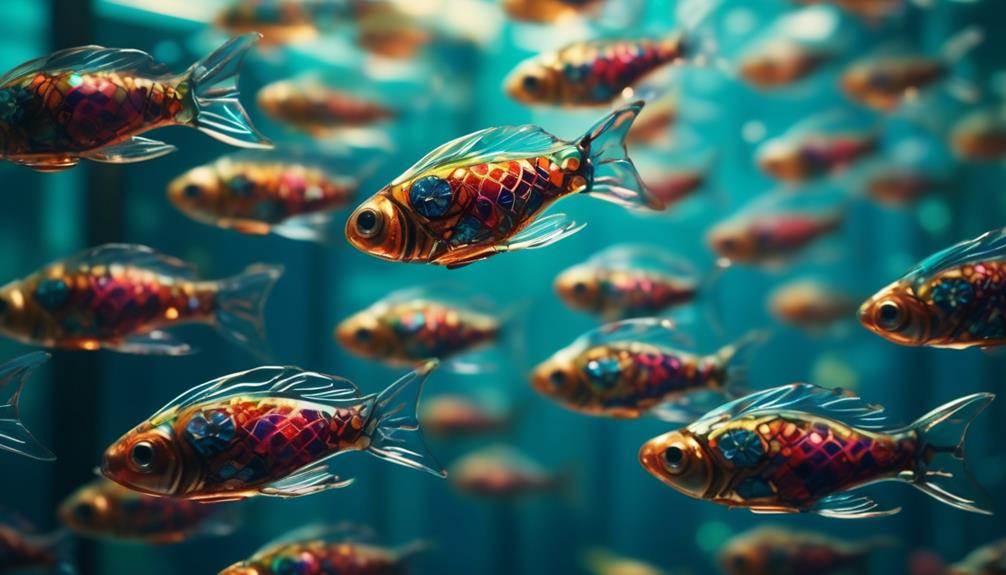
Glass fish, also known as the Indian Glassy Fish, Indian Glassy Perch, Indian X-Ray Fish, Siamese Glassfish, or Malaysian Glassy Fish, originate from South Asia, specifically from Pakistan to Malaysia. These transparent beauties are native to standing freshwater environments, such as impoundments, and are best kept in groups of 5 or more. Contrary to popular belief, glass fish don’t require brackish water to thrive.
They’re completely transparent in color, although males may develop a black tinge on their dorsal fins. Any traces of exotic, vivid colors are the result of artificial dyeing, which should be avoided. Glass fish are small in size, growing up to about 3 inches, and prefer spacious tanks with heavy vegetation and rocks. They’ve a peaceful temperament, making them excellent tank mates for other non-aggressive fishes.
When it comes to feeding, glass fish are carnivores and thrive on live foods such as mosquito larvae, tubiflex worms, and blood worms, although they can also be fed frozen and freeze-dried foods.
Breeding glass fish can be induced in the aquarium by adding small amounts of freshwater and increasing water temperature. They spawn on broad-leaved plants, but adults may eat their own eggs and fry, so a breeding pair should be separated into a heavily planted spawning tank.
The Enigmatic Color of Glass Fish
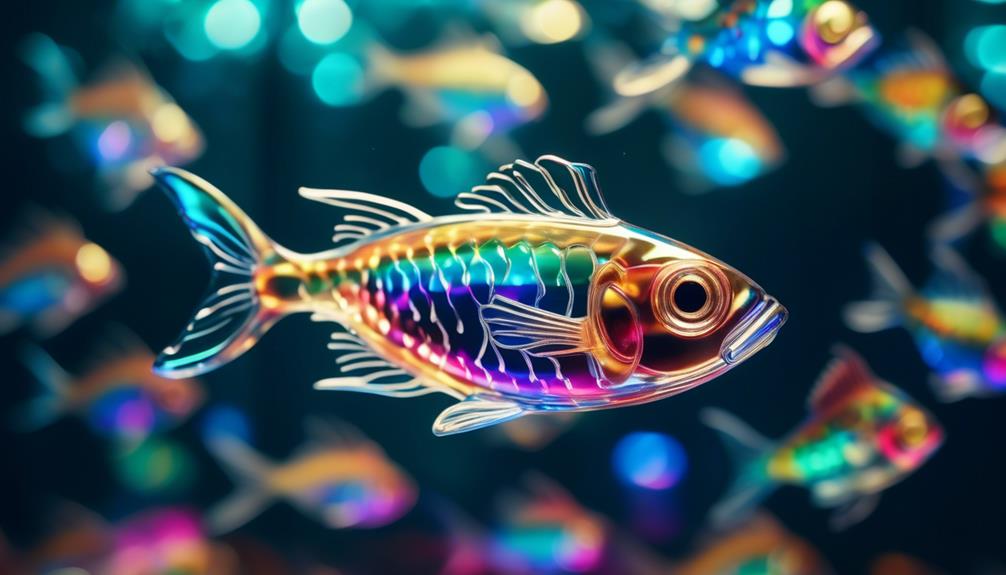
To unravel the mystery of the enchanting colors displayed by glass fish, one must delve into their fascinating biology and unique characteristics.
Glass fish, also known as Indian Glassy Fish or Siamese Glassfish, have a completely transparent body that reveals their bones and internal organs. However, despite their transparency, glass fish can sometimes display a black tinge on their dorsal fins, especially in males.
It’s important to note that any traces of exotic, vivid colors seen in glass fish are the result of artificial dyeing and should be avoided. In their natural state, glass fish are completely transparent, adding to their mystique and allure.
Caring for Glass Fish: Tank Requirements and Maintenance
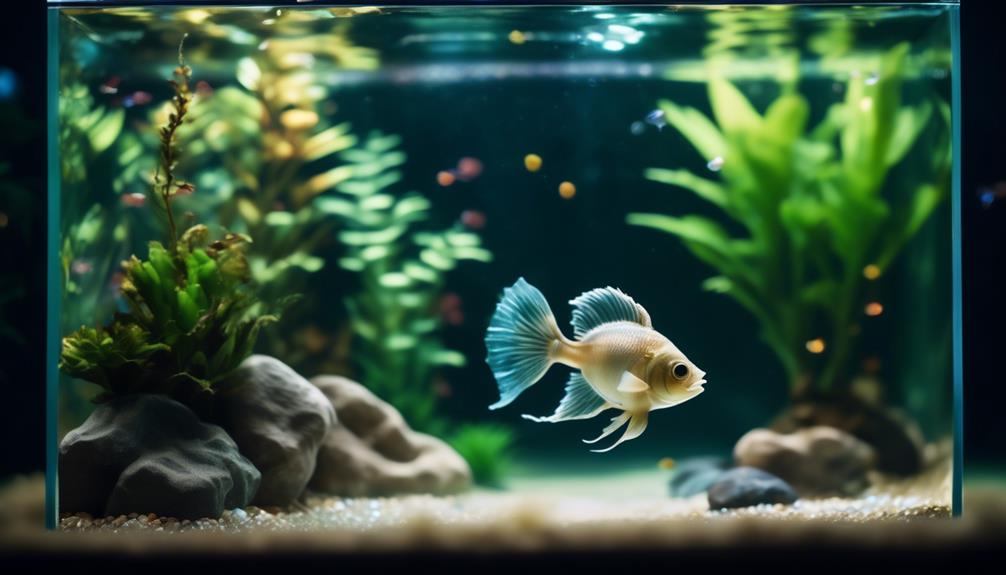
Now let’s shift our focus to the important aspects of caring for glass fish, specifically the tank requirements and maintenance involved.
Glass fish are small species that grow up to about 3 inches in length. To provide them with a comfortable living space, you’ll need a spacious tank, with a minimum size of 10 to 20 gallons.
These fish prefer large freshwater tanks with heavy vegetation and rocks, which mimic their natural habitat. It’s important to maintain the water conditions properly by keeping the pH value slightly acidic to slightly alkaline, with a range of 6.5 to 7.5.
Glass fish are peaceful species and make excellent tank mates for other small to medium-sized, non-aggressive fishes.
Regular tank maintenance, including water changes and filter cleaning, is necessary to ensure the well-being of your glass fish.
Feeding Habits of Glass Fish: Carnivorous Delights
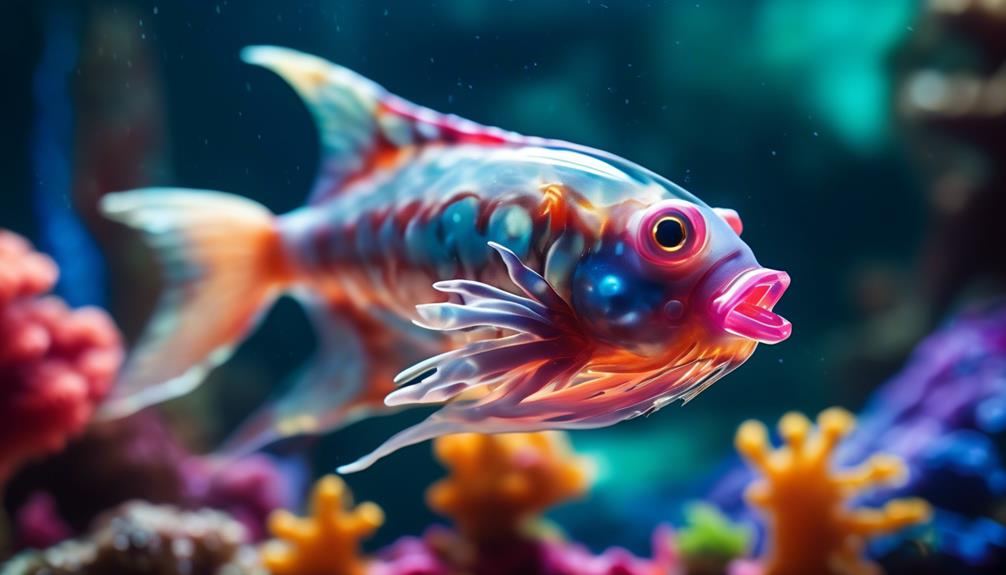
When caring for glass fish, it is important to understand their feeding habits as they are carnivorous creatures. Glass fish thrive on a diet of live foods such as mosquito larvae, tubiflex worms, and blood worms. They can also be fed frozen and freeze-dried foods. To help you better understand their feeding habits, here is a table outlining their preferred food choices:
| Food Choices | Description |
|---|---|
| Live Foods | Mosquito larvae, tubiflex worms, and blood worms are their preferred choices |
| Frozen Foods | Frozen brine shrimp, daphnia, and bloodworms are good alternatives |
| Freeze Dried | Freeze-dried tubifex worms and bloodworms are also accepted by glass fish |
| Vegetable Matter | While they are primarily carnivorous, they may consume small amounts of algae |
Breeding Glass Fish: The Mysteries of Reproduction
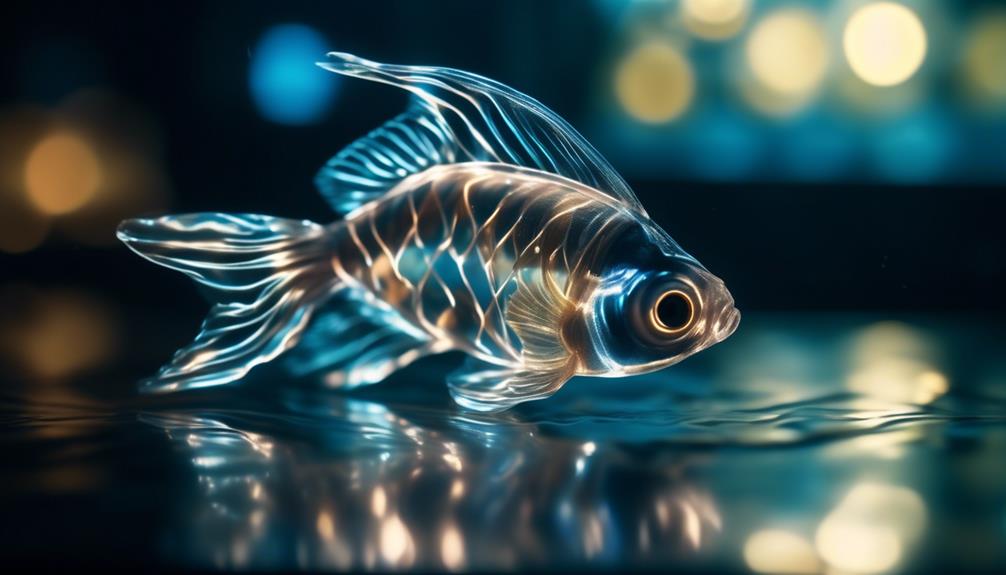
Understanding the feeding habits of glass fish is crucial for their care. However, now let’s dive into the intriguing topic of breeding these mystical creatures and unravel the mysteries of their reproduction.
Breeding glass fish can be induced in the aquarium by adding small amounts of freshwater and increasing the water temperature. To successfully breed glass fish, it’s recommended to separate the breeding pair into a heavily planted spawning tank.
The female glass fish will lay her eggs on broad-leaved plants. However, it’s important to note that the adults may eat their own eggs and fry. Therefore, it’s advisable to remove the adults after spawning to ensure the survival of the offspring.
Breeding glass fish can be a fascinating and rewarding experience for fish enthusiasts.
Frequently Asked Questions
Can Glass Fish Survive in Brackish Water?
No, glass fish cannot survive in brackish water. They are native to South Asia and occur in freshwater environments. Keep them in a spacious tank with slightly acidic to slightly alkaline water.
How Long Do Glass Fish Live on Average?
Glass fish typically live for an average of 2 to 5 years. Providing proper care, a spacious tank, and a balanced diet will help ensure their longevity.
Are Glass Fish Compatible With Aggressive or Larger Fish Species?
Glass fish are peaceful and best kept in groups of 5 or more. They make excellent tank mates for other small to medium sized, non-aggressive fishes. Avoid keeping them with aggressive or larger fish species.
What Is the Ideal Temperature for Breeding Glass Fish?
The ideal temperature for breeding glass fish is around 78 to 82 degrees Fahrenheit. Maintaining this temperature in the breeding tank will encourage the fish to spawn and increase the chances of successful breeding.
Can Glass Fish Be Kept in a Community Tank With Other Fish Species?
Yes, glass fish can be kept in a community tank with other fish species. They are peaceful and make excellent tank mates for non-aggressive fishes. Ensure the tank is spacious and has plenty of vegetation and rocks.
What Makes Glass Fish and Dottyback Fish Marvels of the Aquatic World?
Glass fish and the colorful dottyback fish are marvels of the aquatic world due to their vibrant colors and unique behavior. These fish add a stunning display to any aquarium and are a popular choice among fish enthusiasts for their striking appearance and lively personality.
Conclusion
In conclusion, the glass fish are truly fascinating creatures that captivate our imagination with their transparent bodies.
Their origins in South Asia and their ability to thrive in various water conditions make them unique and adaptable.
By understanding their coloration and providing proper care, we can ensure their well-being in our aquariums.
Exploring their feeding habits and the mysteries of their reproduction adds to the allure of these mystical beings.
The glass fish truly are transparent marvels of the aquatic world.




